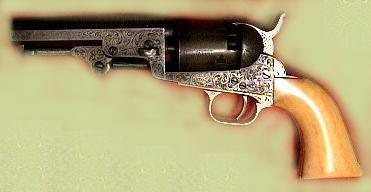Percussion Firearms
The Flint Lock action firearm was a fine piece of
machinery, but it had one strike against it: When fired, a white flash
would exit the breech section. This flash would scare off the intended
prey, moments before the ejection of the bullet. In 1805, Reverend
John Forsyth of Aberdeenshire solved this problem by designing a whole
new breed of firearms, using the percussion cap ignition system. This firing
mechanism was a great step in advancement from its predecessors because
it did not use an exposed flash pan to begin the ignition process. Instead,
it had a simple tube which lead straight into the breech portion of the
gun barrel.
The percussion cap, which is placed on top of the
tube, contains fulminate of mercury, a chemical compound which explodes
when it is struck. When the cap is struck by the hammer, the flames from
the exploding fulminate of mercury go down the tube, into the gun barrel,
and ignite the powder inside the barrel to propel the bullet, without any
flash or puff of smoke. Now, for the first time a gunmen can pull
the trigger and send a bullet to a target without any time delay.
The other advantages to the system are: greater reliability, since the
cap was almost certain to explode when struck, and greater protection to
water or dampness.
The percussion cap system was the key to making
very reliable rotating-block or revolver guns which would fire reliably,
without misfiring. By the 1810's, only a few years after Reverend
John Forsyth introduced his new firearm to the public, many manufacturers
had began producing these multiple-shot sidearms in mass quantities. The
percussion cap firing system allowed a soldier to carry a weapon of precision
and reliability which was used to devastating effect in the U.S. Civil
War.










|
|
Updated June 18th, 1998
Daniel Berry